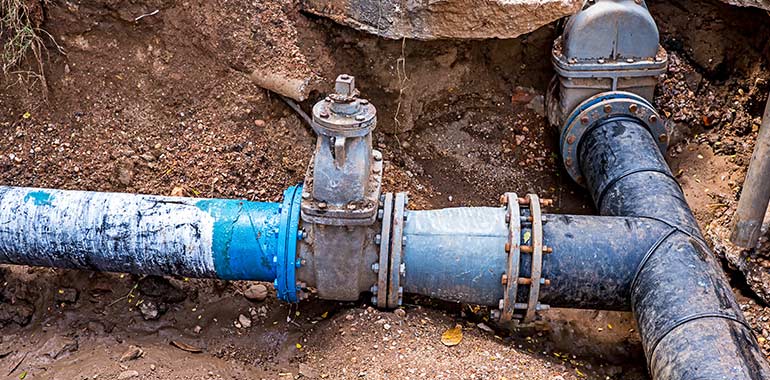If you reside in an older house that’s succumbing to overgrowth, chances are you need sewer line repair eventually or completely replaced. In this blog post, the sewer pipe repair specialists at T-Top Plumbing recommend six musts for a successful sewer line repair.
Just like any other drain inside a house, your main drain line is vulnerable to a clog or stoppage. Signs of this issue can be relatively inconspicuous. It might be something as seemingly innocent as your sink or shower not draining properly. You immediately think it’s that drain that’s clogged. Same thing with a backed up basement drain. You assume the clog or stoppage is in that particular drain. Perhaps you purchase a drain cleaning product at the store, give it a whirl, only to find the problem isn’t resolved.
Few people realize that any stoppage or overflow in your home might be stemming from a problem with the main drain line. This is the line running from the curb, through your yard, into your home.
So, how does this type of clog even happen? There are a few causes of these blockages:
- Food and soap build-up in sewer drains or main sewer lines
- Tree roots entering sewer lines
- Collapsed drain lines from deteriorating old drain pipes
- Debris entering drain system from incorrect pipe connections
The good news is regular upkeep and maintenance can help prevent most sewer line stoppages. However, sewer lines beyond any economical or manageable repair need to be immediately and efficiently replaced.
Here are a few musts if you want to have a successful sewer line repair.
Find a Great Plumber
You ideally want a company that’s professional and well-reviewed. Plumbers can be found through Google searches, social media, or traditional paid TV, radio, print, and billboard advertisements. Just be sure to thoroughly check out reviews. Is the plumber you’re considering trustworthy? Does it seem like they’re efficient at identifying the root cause of a problem? Are they honest and upfront with pricing? Do they follow through when it comes to service and resolving the issue they’ve been called on to fix? Are they familiar with your area and aware of building codes and permits they’ll need to obtain? From there, it’s just a matter of liking their estimate and proposed course of action.
Know Whether the Dig Is Absolutely Necessary
Trenchless technology has enabled pipe repair and replacement with no digging and no mess. But many plumbers prefer digging. They either lack the equipment or expertise/familiarity for trenchless. If digging is mentioned, confirm that it’s absolutely necessary. With any dig, there’s always the risk of unforeseen damage. Not to mention the added cost of landscaping after the pipeline has been repaired or replaced. This is why an accurate diagnosis is important. You want an exact reason and justification for any dig. Before any shovel hits the dirt, you need to know what’s going on and what the end game is.
Remove the Actual Cause of the Clog
Any source of a clog, particularly roots or plants, need to be completely removed. Even if a complete sewer line has been replaced, roots must be removed entirely. If they aren’t, the clog will just reoccur in time despite the new sewer line.
Be Mindful of the Most Cost Effective Option
While repairing a section of your sewer line is likely less expensive than replacing the entire sewer line, it might not be as cost-effective in the long run. Especially if the entire pipe eventually needs to be replaced at a later date. In that event, the cost for a complete replacement at a later date will be more than replacing the entire sewer line from the start. The cost to replace an entire sewer line may rise over time. Permits, if needed for the repair, will likely need to be acquired all over again for a replacement. Not to mention the same area may need to be excavated at a later date – again, adding to overall costs.
This is why it’s important to weigh the short-term cost-benefit of sewer line repairs vs. the long-term cost-benefit of sewer line replacement.
Take a Look Into Trenchless Sewer Line Repair and Replacement
Trenchless sewer repair and replacement is available through some companies. A trenchless sewer line might be used to replace a section or even coat the entire system as a complete replacement. Installed through the main sewer line, trenchless technology uses a much stronger line to seal cracks or breaks for a much more effective and durable sewer line repair.
Remember sewer blockage isn’t just an issue for the property owner or people residing in the house. It can also impact the lives of your neighbors. Trenchless sewer line repair and replacement helps safeguard your property, as well as the properties around you, from more serious problems associated with older deteriorating lines.





